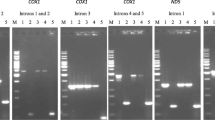Abstract
In the great majority of sexual eukaryotes, mitochondrial genomes are inherited almost exclusively from a single parent. While many hypotheses have been proposed to explain this phenomenon, very little is known about the genetic elements controlling uniparental mitochondria inheritance. In the bipolar, isogamous basidiomycete yeast Cryptococcus neoformans, progeny from crosses between strains of mating type a (MATa) and mating type α (MATα) typically inherit mitochondrial DNA (mtDNA) from the MATa parent. We recently demonstrated that a mating type α (MATα)-specific gene SXI1α, controls mitochondrial inheritance in C. neoformans. Here, we show that another homeodomain gene SXI2a in the alternative mating type MATa is also required for uniparental mtDNA inheritance in this fungus. Disruption of SXI2a resulted in biparental mtDNA inheritance in the zygote population with significant numbers of progeny inheriting mtDNA from the MATa parent, the MATα parent, and both the MATa and the MATα parents. In addition, progeny from same-sex mating between MATα strains showed a biparental mitochondrial inheritance pattern. Our results suggest that SXI1α and SXI2a coordinately control uniparental mitochondrial inheritance in C. neoformans.
Similar content being viewed by others
References
Birky Jr. CW (2001) The inheritance of genes in mitochondria and chloroplasts: laws, mechanisms, and models. Ann Rev Genet 35:125–148
Boynton JE, Harris EH, Burkhart BD, Lamerson PM, Gillham NW (1987) Transmission of mitochondrial and chloroplast genomes in crosses of Chlamydomonas. Proc Natl Acad Sci USA 84:2391–2395
Brachmann A, Weinwierl G, Kamper J, Kahmann R (2001) Identification of genes in the bW/bE regulatory cascade in Ustilago maydis. Mol Microbiol 42:1047–1063
Brown AJ, Casselton LA (2001) Mating in mushrooms: increases the chances but prolonging the affair. Trends Genet 17:393–400
Gibson W (2001) Sex and evolution in trypanosomes. Int J Parasitol 31:643–647
Gillham NW (1994) Organelle genes and genomes. Oxford University Press, New York
Haqq CM, Donahoe PK (1998) Regulation of sexual dimorphism in mammals. Physiol Rev 78:1–33
Hull CM, Davidson RC, Heitman J (2002) Cell identity and sexual development in Cryptococcus neoformans are controlled by the mating-type-specific homeodomain protein Sxi1α. Genes Dev 16:3046–3060
Hull CM, Boily MJ, Heitman J (2005) Sex-specific homeodomain proteins Sxi1α and Sxi2a coordinately regulate sexual development in Cryptococcus neoformans. Eukaryot Cell 4:526–535
Idnurm A, Heitman J (2005) Light controls growth and development via a conserved pathway in the fungal kingdom. PLoS Biol 3(4):e95
Kües U, Walser PJ, Klaus MJ, Aebi M (2002) Influence of activated A and B mating-type pathways on developmental processes in the basidiomycete Coprinus cinereus. Mol Genet Genom 268:262–271
Kurvari V, Grishin NV, Snell WJ (1998) A gamete-specific, sex-limited homeodomain protein in Chlamydomonas. J Cell Biol 143:1971–1980
Lin X, Hull CM, Heitman J (2005) Sexual reproduction between partners of the same mating type in Cryptococcus neoformans. Nature 434:1017–1021
McClelland CM, Chang YC, Varma A, Kwon-Chung KJ (2004) Uniqueness of the mating system in Cryptococcus neoformans. Trends Microbiol 12:208–212
Mirfakhrai M, Tanaka Y, Yanagisawa K (1990) Evidence for mitochondrial DNA polymorphism and uniparental inheritance in the cellular slime mold Polysphondylium pallidum: effect of intraspecies mating on mitochondrial transmission. Genetics 124:607–613
Moriyama Y, Kawano S (2003) Rapid, selective digestion of mitochondrial DNA in accordance with the matA hierarchy of multiallelic mating types in the mitochondrial inheritance of Physarum polycephalum. Genetics 164:963–975
Nishimura Y, Misumi O, Kato K, Inada N, Higashiyama T, Momoyama Y, Kuroiwa T (2002) An mt(+) gamete-specific nuclease that targets mt(−) chloroplasts during sexual reproduction in C. reinhardtii. Genes Dev 16:1116–1128
Sutovsky P, Moreno RD, Ramalho-Santos J, Dominko T, Simerly C, Schatten G (2000) Ubiquitinated sperm mitochondria, selective proteolysis, and the regulation of mitochondrial inheritance in mammalian embryos. Biol Reprod 63:582–590
Toffaletti DL, Nielsen K, Dietrich F, Heitman J, Perfect JR (2004) Cryptococcus neoformans mitochondrial genomes from serotype A and D strains do not influence virulence. Curr Genet 46:193–204
Umen JG, Goodenough UW (2001) Chloroplast DNA methylation and inheritance in Chlamydomonas. Genes Dev 15:2585–2597
Xu J (2002) Mitochondrial DNA polymorphisms in the human pathogenic fungus Cryptococcus neoformans. Curr Genet 41:43–47
Xu J (2005) The inheritance of organelle genes and genomes: patterns and mechanisms. Genome 48:951–958
Xu J, Ali RY, Gregory DA, Amick D, Lambert SE, Yoell HJ, Vilgalys RJ, Mitchell TG (2000a) Uniparental mitochondrial transmission in sexual crosses in Cryptococcus neoformans. Curr Microbiol 40:269–273
Xu J, Ramos A, Vilgalys R, Mitchell TG (2000b) Clonal and spontaneous origins of fluconazole resistance in Candida albicans. J Clin Microbiol 38:1214–1220
Yan Z, Sun S, Shahid M, Xu J (2006) Environment factors can influence mitochondrial inheritance in the fungus Cryptococcus neoformans. Fungal Genet Biol (in press)
Yan Z, Hull CM, Heitman J, Sun S, Xu J (2004) SXI1α controls uniparental mitochondrial inheritance in Cryptococcus neoformans. Curr Biol 14:R743-R744
Yan Z, Xu J (2003) Mitochondria are inherited from the MATa parent in crosses of the basidiomycete fungus Cryptococcus neoformans. Genetics 163:1315–1325
Yan Z, Xu J (2005) Fungal mitochondrial inheritance and evolution. In Xu J (ed) Evolutionary genetics of fungi. Horizon Scientific Press, England, pp 221–252
Acknowledgments
This project is supported by grants from the Premier’s Research Excellence Award (J. Xu), the Natural Science and Engineering Research Council (NSERC) of Canada (J. Xu), Z. Yan and S. Sun thank the financial support of an NSERC scholarship and an Ontario Graduate Scholarship, respectively.
Author information
Authors and Affiliations
Corresponding author
Additional information
Communicated by U. Kück.
Rights and permissions
About this article
Cite this article
Yan, Z., Hull, C.M., Sun, S. et al. The mating type-specific homeodomain genes SXI1α and SXI2a coordinately control uniparental mitochondrial inheritance in Cryptococcus neoformans . Curr Genet 51, 187–195 (2007). https://doi.org/10.1007/s00294-006-0115-9
Received:
Accepted:
Published:
Issue Date:
DOI: https://doi.org/10.1007/s00294-006-0115-9




